Combating Bullying: An Educational Program for Nursing Students
VerifiedAdded on 2023/05/30
|6
|1578
|157
Report
AI Summary
This report addresses the pervasive issue of bullying in nursing, often referred to as "nurses eat their young," and its detrimental effects on nurses' mental health, patient outcomes, and healthcare organizations' reputations. The report highlights the high rates of bullying among nurses, its contribution to nurse shortages, and its impact on both victims and witnesses. To combat this issue, the report proposes an educational program targeted at nursing students, both junior and senior, to educate them about the negative consequences of bullying and provide strategies for prevention. The program includes web-based and classroom-based PowerPoint presentations, as well as role-play simulations. The report also includes a cost/budget justification and requests feedback on the proposed program, emphasizing that proper education can help prevent and uproot bullying from the lives of nursing students.
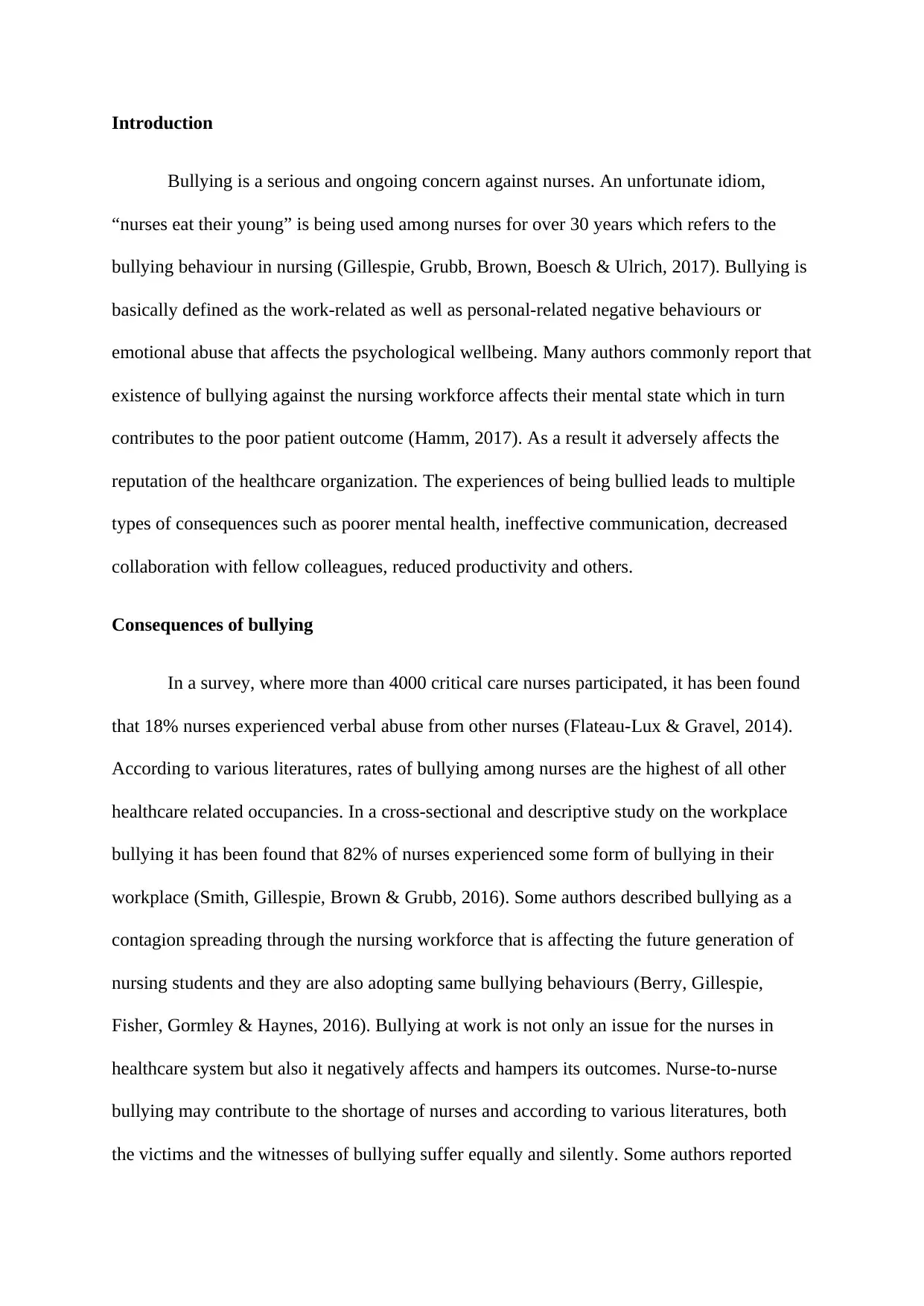
Introduction
Bullying is a serious and ongoing concern against nurses. An unfortunate idiom,
“nurses eat their young” is being used among nurses for over 30 years which refers to the
bullying behaviour in nursing (Gillespie, Grubb, Brown, Boesch & Ulrich, 2017). Bullying is
basically defined as the work-related as well as personal-related negative behaviours or
emotional abuse that affects the psychological wellbeing. Many authors commonly report that
existence of bullying against the nursing workforce affects their mental state which in turn
contributes to the poor patient outcome (Hamm, 2017). As a result it adversely affects the
reputation of the healthcare organization. The experiences of being bullied leads to multiple
types of consequences such as poorer mental health, ineffective communication, decreased
collaboration with fellow colleagues, reduced productivity and others.
Consequences of bullying
In a survey, where more than 4000 critical care nurses participated, it has been found
that 18% nurses experienced verbal abuse from other nurses (Flateau-Lux & Gravel, 2014).
According to various literatures, rates of bullying among nurses are the highest of all other
healthcare related occupancies. In a cross-sectional and descriptive study on the workplace
bullying it has been found that 82% of nurses experienced some form of bullying in their
workplace (Smith, Gillespie, Brown & Grubb, 2016). Some authors described bullying as a
contagion spreading through the nursing workforce that is affecting the future generation of
nursing students and they are also adopting same bullying behaviours (Berry, Gillespie,
Fisher, Gormley & Haynes, 2016). Bullying at work is not only an issue for the nurses in
healthcare system but also it negatively affects and hampers its outcomes. Nurse-to-nurse
bullying may contribute to the shortage of nurses and according to various literatures, both
the victims and the witnesses of bullying suffer equally and silently. Some authors reported
Bullying is a serious and ongoing concern against nurses. An unfortunate idiom,
“nurses eat their young” is being used among nurses for over 30 years which refers to the
bullying behaviour in nursing (Gillespie, Grubb, Brown, Boesch & Ulrich, 2017). Bullying is
basically defined as the work-related as well as personal-related negative behaviours or
emotional abuse that affects the psychological wellbeing. Many authors commonly report that
existence of bullying against the nursing workforce affects their mental state which in turn
contributes to the poor patient outcome (Hamm, 2017). As a result it adversely affects the
reputation of the healthcare organization. The experiences of being bullied leads to multiple
types of consequences such as poorer mental health, ineffective communication, decreased
collaboration with fellow colleagues, reduced productivity and others.
Consequences of bullying
In a survey, where more than 4000 critical care nurses participated, it has been found
that 18% nurses experienced verbal abuse from other nurses (Flateau-Lux & Gravel, 2014).
According to various literatures, rates of bullying among nurses are the highest of all other
healthcare related occupancies. In a cross-sectional and descriptive study on the workplace
bullying it has been found that 82% of nurses experienced some form of bullying in their
workplace (Smith, Gillespie, Brown & Grubb, 2016). Some authors described bullying as a
contagion spreading through the nursing workforce that is affecting the future generation of
nursing students and they are also adopting same bullying behaviours (Berry, Gillespie,
Fisher, Gormley & Haynes, 2016). Bullying at work is not only an issue for the nurses in
healthcare system but also it negatively affects and hampers its outcomes. Nurse-to-nurse
bullying may contribute to the shortage of nurses and according to various literatures, both
the victims and the witnesses of bullying suffer equally and silently. Some authors reported
Paraphrase This Document
Need a fresh take? Get an instant paraphrase of this document with our AI Paraphraser
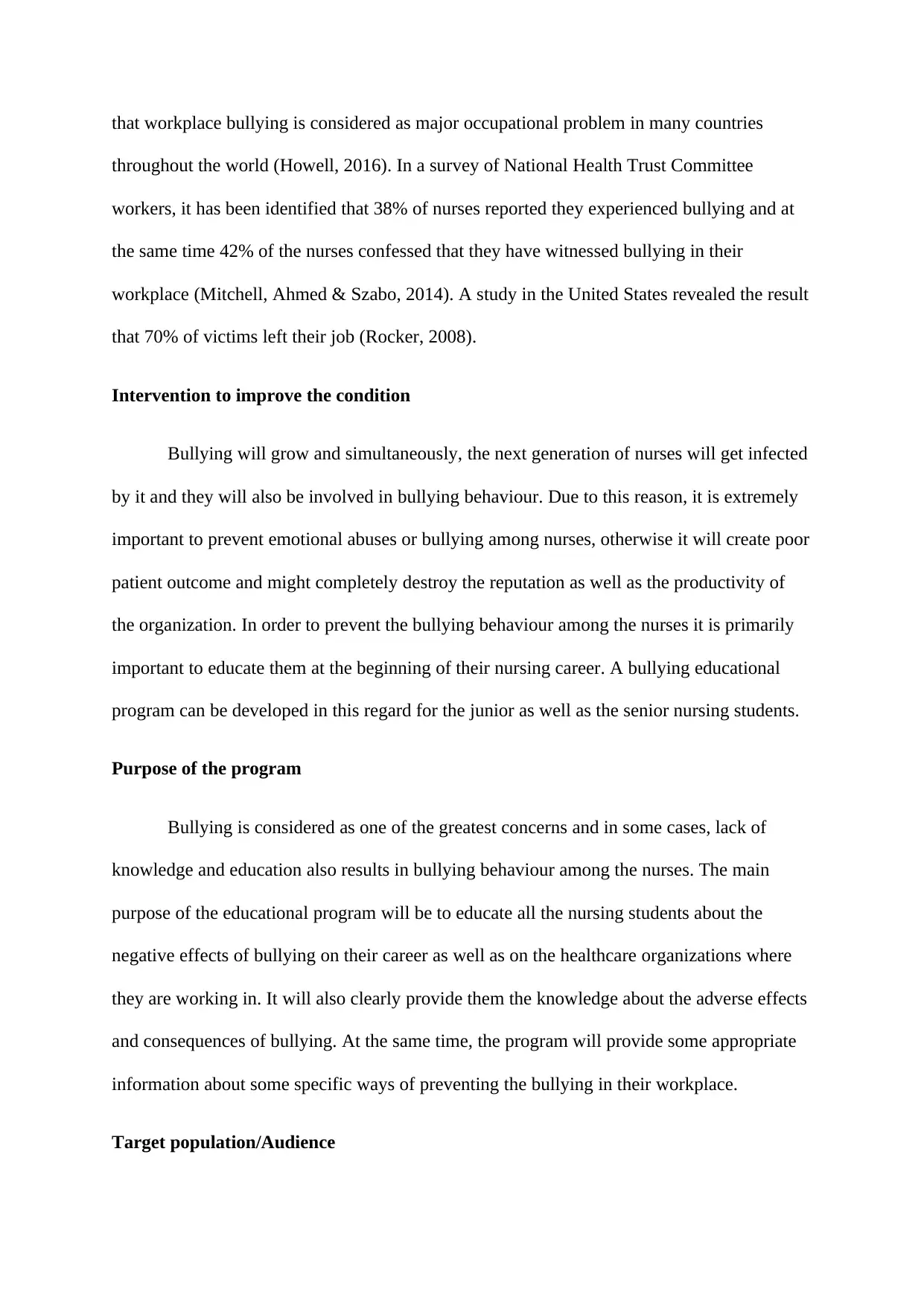
that workplace bullying is considered as major occupational problem in many countries
throughout the world (Howell, 2016). In a survey of National Health Trust Committee
workers, it has been identified that 38% of nurses reported they experienced bullying and at
the same time 42% of the nurses confessed that they have witnessed bullying in their
workplace (Mitchell, Ahmed & Szabo, 2014). A study in the United States revealed the result
that 70% of victims left their job (Rocker, 2008).
Intervention to improve the condition
Bullying will grow and simultaneously, the next generation of nurses will get infected
by it and they will also be involved in bullying behaviour. Due to this reason, it is extremely
important to prevent emotional abuses or bullying among nurses, otherwise it will create poor
patient outcome and might completely destroy the reputation as well as the productivity of
the organization. In order to prevent the bullying behaviour among the nurses it is primarily
important to educate them at the beginning of their nursing career. A bullying educational
program can be developed in this regard for the junior as well as the senior nursing students.
Purpose of the program
Bullying is considered as one of the greatest concerns and in some cases, lack of
knowledge and education also results in bullying behaviour among the nurses. The main
purpose of the educational program will be to educate all the nursing students about the
negative effects of bullying on their career as well as on the healthcare organizations where
they are working in. It will also clearly provide them the knowledge about the adverse effects
and consequences of bullying. At the same time, the program will provide some appropriate
information about some specific ways of preventing the bullying in their workplace.
Target population/Audience
throughout the world (Howell, 2016). In a survey of National Health Trust Committee
workers, it has been identified that 38% of nurses reported they experienced bullying and at
the same time 42% of the nurses confessed that they have witnessed bullying in their
workplace (Mitchell, Ahmed & Szabo, 2014). A study in the United States revealed the result
that 70% of victims left their job (Rocker, 2008).
Intervention to improve the condition
Bullying will grow and simultaneously, the next generation of nurses will get infected
by it and they will also be involved in bullying behaviour. Due to this reason, it is extremely
important to prevent emotional abuses or bullying among nurses, otherwise it will create poor
patient outcome and might completely destroy the reputation as well as the productivity of
the organization. In order to prevent the bullying behaviour among the nurses it is primarily
important to educate them at the beginning of their nursing career. A bullying educational
program can be developed in this regard for the junior as well as the senior nursing students.
Purpose of the program
Bullying is considered as one of the greatest concerns and in some cases, lack of
knowledge and education also results in bullying behaviour among the nurses. The main
purpose of the educational program will be to educate all the nursing students about the
negative effects of bullying on their career as well as on the healthcare organizations where
they are working in. It will also clearly provide them the knowledge about the adverse effects
and consequences of bullying. At the same time, the program will provide some appropriate
information about some specific ways of preventing the bullying in their workplace.
Target population/Audience
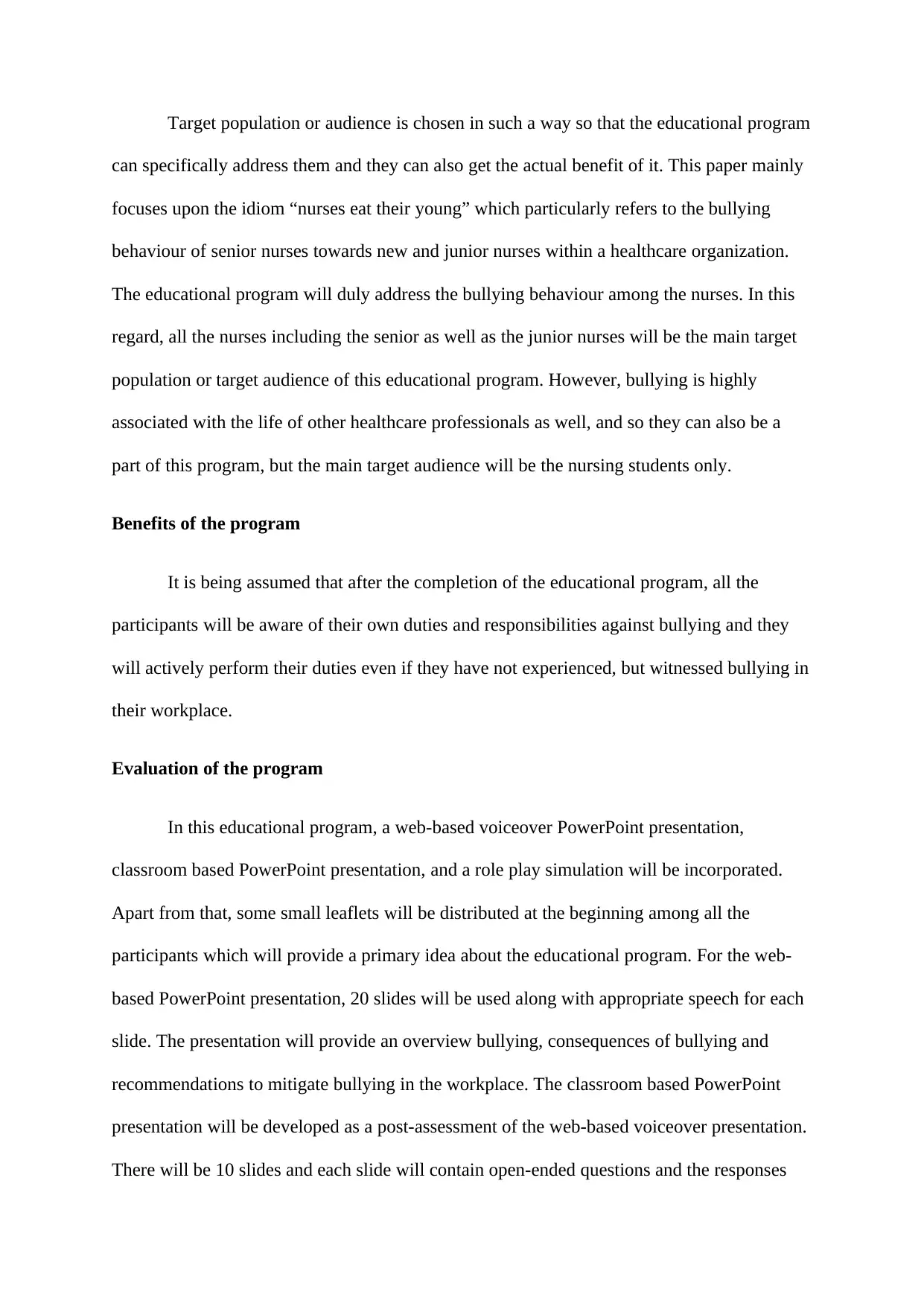
Target population or audience is chosen in such a way so that the educational program
can specifically address them and they can also get the actual benefit of it. This paper mainly
focuses upon the idiom “nurses eat their young” which particularly refers to the bullying
behaviour of senior nurses towards new and junior nurses within a healthcare organization.
The educational program will duly address the bullying behaviour among the nurses. In this
regard, all the nurses including the senior as well as the junior nurses will be the main target
population or target audience of this educational program. However, bullying is highly
associated with the life of other healthcare professionals as well, and so they can also be a
part of this program, but the main target audience will be the nursing students only.
Benefits of the program
It is being assumed that after the completion of the educational program, all the
participants will be aware of their own duties and responsibilities against bullying and they
will actively perform their duties even if they have not experienced, but witnessed bullying in
their workplace.
Evaluation of the program
In this educational program, a web-based voiceover PowerPoint presentation,
classroom based PowerPoint presentation, and a role play simulation will be incorporated.
Apart from that, some small leaflets will be distributed at the beginning among all the
participants which will provide a primary idea about the educational program. For the web-
based PowerPoint presentation, 20 slides will be used along with appropriate speech for each
slide. The presentation will provide an overview bullying, consequences of bullying and
recommendations to mitigate bullying in the workplace. The classroom based PowerPoint
presentation will be developed as a post-assessment of the web-based voiceover presentation.
There will be 10 slides and each slide will contain open-ended questions and the responses
can specifically address them and they can also get the actual benefit of it. This paper mainly
focuses upon the idiom “nurses eat their young” which particularly refers to the bullying
behaviour of senior nurses towards new and junior nurses within a healthcare organization.
The educational program will duly address the bullying behaviour among the nurses. In this
regard, all the nurses including the senior as well as the junior nurses will be the main target
population or target audience of this educational program. However, bullying is highly
associated with the life of other healthcare professionals as well, and so they can also be a
part of this program, but the main target audience will be the nursing students only.
Benefits of the program
It is being assumed that after the completion of the educational program, all the
participants will be aware of their own duties and responsibilities against bullying and they
will actively perform their duties even if they have not experienced, but witnessed bullying in
their workplace.
Evaluation of the program
In this educational program, a web-based voiceover PowerPoint presentation,
classroom based PowerPoint presentation, and a role play simulation will be incorporated.
Apart from that, some small leaflets will be distributed at the beginning among all the
participants which will provide a primary idea about the educational program. For the web-
based PowerPoint presentation, 20 slides will be used along with appropriate speech for each
slide. The presentation will provide an overview bullying, consequences of bullying and
recommendations to mitigate bullying in the workplace. The classroom based PowerPoint
presentation will be developed as a post-assessment of the web-based voiceover presentation.
There will be 10 slides and each slide will contain open-ended questions and the responses
⊘ This is a preview!⊘
Do you want full access?
Subscribe today to unlock all pages.

Trusted by 1+ million students worldwide
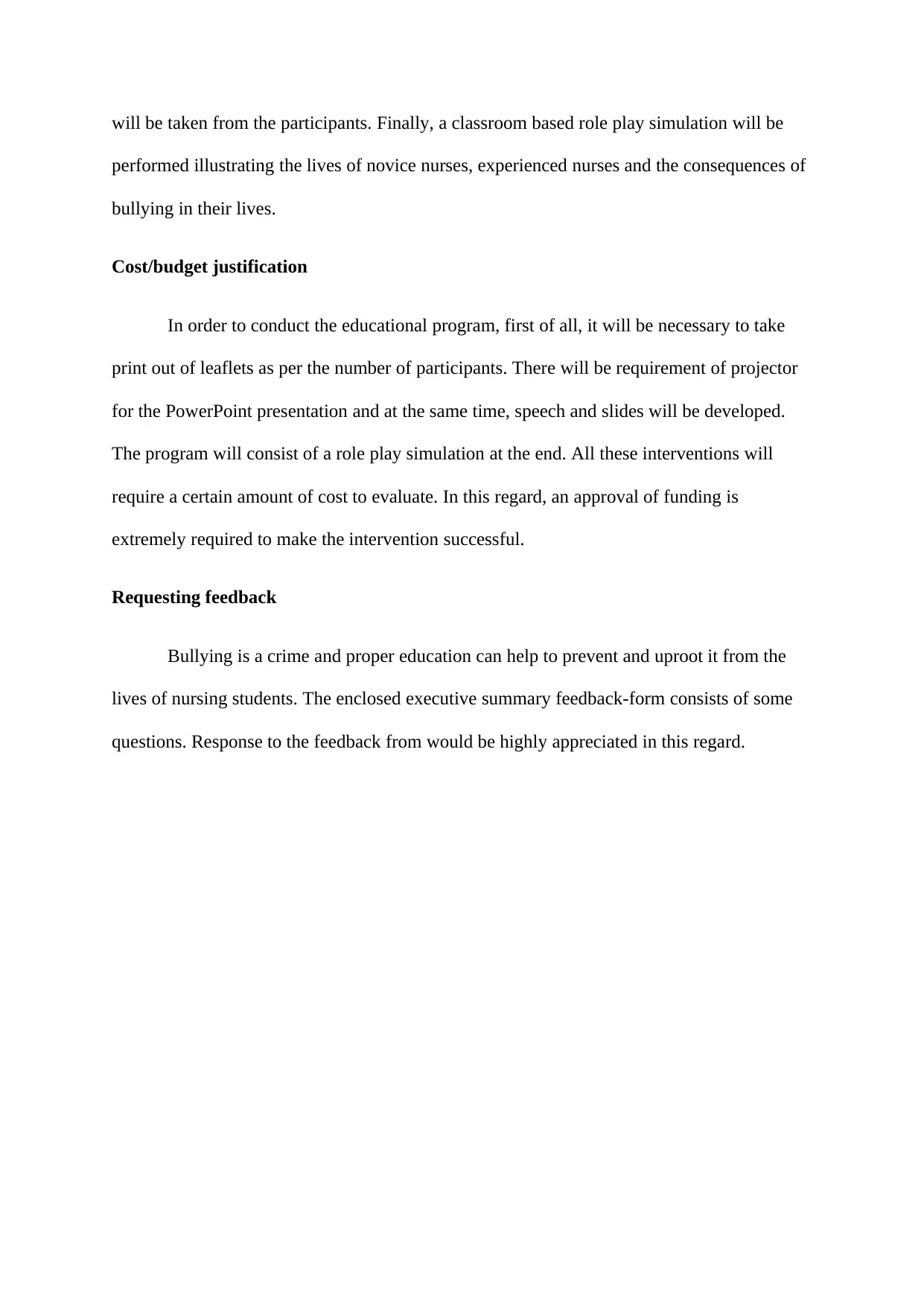
will be taken from the participants. Finally, a classroom based role play simulation will be
performed illustrating the lives of novice nurses, experienced nurses and the consequences of
bullying in their lives.
Cost/budget justification
In order to conduct the educational program, first of all, it will be necessary to take
print out of leaflets as per the number of participants. There will be requirement of projector
for the PowerPoint presentation and at the same time, speech and slides will be developed.
The program will consist of a role play simulation at the end. All these interventions will
require a certain amount of cost to evaluate. In this regard, an approval of funding is
extremely required to make the intervention successful.
Requesting feedback
Bullying is a crime and proper education can help to prevent and uproot it from the
lives of nursing students. The enclosed executive summary feedback-form consists of some
questions. Response to the feedback from would be highly appreciated in this regard.
performed illustrating the lives of novice nurses, experienced nurses and the consequences of
bullying in their lives.
Cost/budget justification
In order to conduct the educational program, first of all, it will be necessary to take
print out of leaflets as per the number of participants. There will be requirement of projector
for the PowerPoint presentation and at the same time, speech and slides will be developed.
The program will consist of a role play simulation at the end. All these interventions will
require a certain amount of cost to evaluate. In this regard, an approval of funding is
extremely required to make the intervention successful.
Requesting feedback
Bullying is a crime and proper education can help to prevent and uproot it from the
lives of nursing students. The enclosed executive summary feedback-form consists of some
questions. Response to the feedback from would be highly appreciated in this regard.
Paraphrase This Document
Need a fresh take? Get an instant paraphrase of this document with our AI Paraphraser
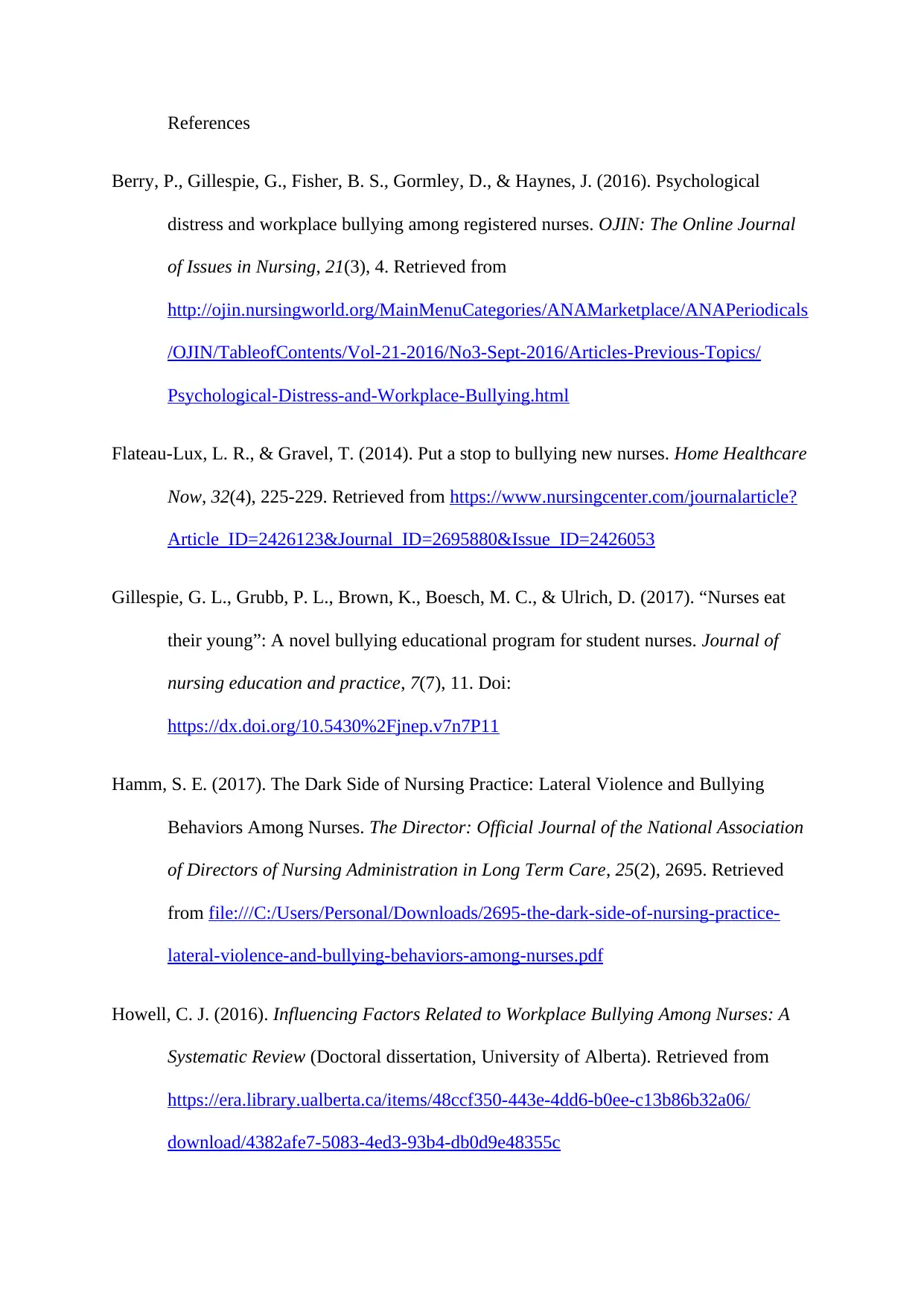
References
Berry, P., Gillespie, G., Fisher, B. S., Gormley, D., & Haynes, J. (2016). Psychological
distress and workplace bullying among registered nurses. OJIN: The Online Journal
of Issues in Nursing, 21(3), 4. Retrieved from
http://ojin.nursingworld.org/MainMenuCategories/ANAMarketplace/ANAPeriodicals
/OJIN/TableofContents/Vol-21-2016/No3-Sept-2016/Articles-Previous-Topics/
Psychological-Distress-and-Workplace-Bullying.html
Flateau-Lux, L. R., & Gravel, T. (2014). Put a stop to bullying new nurses. Home Healthcare
Now, 32(4), 225-229. Retrieved from https://www.nursingcenter.com/journalarticle?
Article_ID=2426123&Journal_ID=2695880&Issue_ID=2426053
Gillespie, G. L., Grubb, P. L., Brown, K., Boesch, M. C., & Ulrich, D. (2017). “Nurses eat
their young”: A novel bullying educational program for student nurses. Journal of
nursing education and practice, 7(7), 11. Doi:
https://dx.doi.org/10.5430%2Fjnep.v7n7P11
Hamm, S. E. (2017). The Dark Side of Nursing Practice: Lateral Violence and Bullying
Behaviors Among Nurses. The Director: Official Journal of the National Association
of Directors of Nursing Administration in Long Term Care, 25(2), 2695. Retrieved
from file:///C:/Users/Personal/Downloads/2695-the-dark-side-of-nursing-practice-
lateral-violence-and-bullying-behaviors-among-nurses.pdf
Howell, C. J. (2016). Influencing Factors Related to Workplace Bullying Among Nurses: A
Systematic Review (Doctoral dissertation, University of Alberta). Retrieved from
https://era.library.ualberta.ca/items/48ccf350-443e-4dd6-b0ee-c13b86b32a06/
download/4382afe7-5083-4ed3-93b4-db0d9e48355c
Berry, P., Gillespie, G., Fisher, B. S., Gormley, D., & Haynes, J. (2016). Psychological
distress and workplace bullying among registered nurses. OJIN: The Online Journal
of Issues in Nursing, 21(3), 4. Retrieved from
http://ojin.nursingworld.org/MainMenuCategories/ANAMarketplace/ANAPeriodicals
/OJIN/TableofContents/Vol-21-2016/No3-Sept-2016/Articles-Previous-Topics/
Psychological-Distress-and-Workplace-Bullying.html
Flateau-Lux, L. R., & Gravel, T. (2014). Put a stop to bullying new nurses. Home Healthcare
Now, 32(4), 225-229. Retrieved from https://www.nursingcenter.com/journalarticle?
Article_ID=2426123&Journal_ID=2695880&Issue_ID=2426053
Gillespie, G. L., Grubb, P. L., Brown, K., Boesch, M. C., & Ulrich, D. (2017). “Nurses eat
their young”: A novel bullying educational program for student nurses. Journal of
nursing education and practice, 7(7), 11. Doi:
https://dx.doi.org/10.5430%2Fjnep.v7n7P11
Hamm, S. E. (2017). The Dark Side of Nursing Practice: Lateral Violence and Bullying
Behaviors Among Nurses. The Director: Official Journal of the National Association
of Directors of Nursing Administration in Long Term Care, 25(2), 2695. Retrieved
from file:///C:/Users/Personal/Downloads/2695-the-dark-side-of-nursing-practice-
lateral-violence-and-bullying-behaviors-among-nurses.pdf
Howell, C. J. (2016). Influencing Factors Related to Workplace Bullying Among Nurses: A
Systematic Review (Doctoral dissertation, University of Alberta). Retrieved from
https://era.library.ualberta.ca/items/48ccf350-443e-4dd6-b0ee-c13b86b32a06/
download/4382afe7-5083-4ed3-93b4-db0d9e48355c
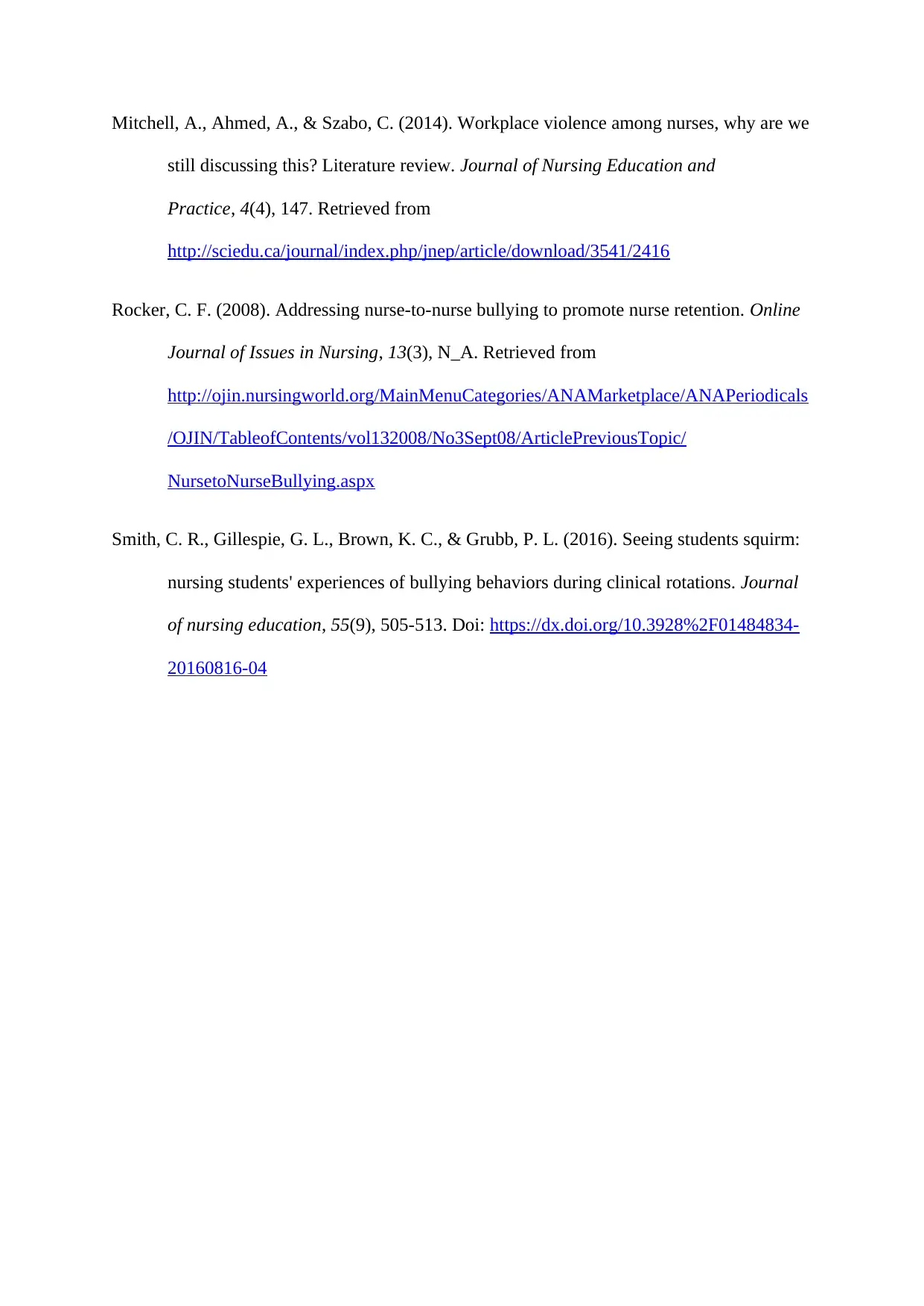
Mitchell, A., Ahmed, A., & Szabo, C. (2014). Workplace violence among nurses, why are we
still discussing this? Literature review. Journal of Nursing Education and
Practice, 4(4), 147. Retrieved from
http://sciedu.ca/journal/index.php/jnep/article/download/3541/2416
Rocker, C. F. (2008). Addressing nurse-to-nurse bullying to promote nurse retention. Online
Journal of Issues in Nursing, 13(3), N_A. Retrieved from
http://ojin.nursingworld.org/MainMenuCategories/ANAMarketplace/ANAPeriodicals
/OJIN/TableofContents/vol132008/No3Sept08/ArticlePreviousTopic/
NursetoNurseBullying.aspx
Smith, C. R., Gillespie, G. L., Brown, K. C., & Grubb, P. L. (2016). Seeing students squirm:
nursing students' experiences of bullying behaviors during clinical rotations. Journal
of nursing education, 55(9), 505-513. Doi: https://dx.doi.org/10.3928%2F01484834-
20160816-04
still discussing this? Literature review. Journal of Nursing Education and
Practice, 4(4), 147. Retrieved from
http://sciedu.ca/journal/index.php/jnep/article/download/3541/2416
Rocker, C. F. (2008). Addressing nurse-to-nurse bullying to promote nurse retention. Online
Journal of Issues in Nursing, 13(3), N_A. Retrieved from
http://ojin.nursingworld.org/MainMenuCategories/ANAMarketplace/ANAPeriodicals
/OJIN/TableofContents/vol132008/No3Sept08/ArticlePreviousTopic/
NursetoNurseBullying.aspx
Smith, C. R., Gillespie, G. L., Brown, K. C., & Grubb, P. L. (2016). Seeing students squirm:
nursing students' experiences of bullying behaviors during clinical rotations. Journal
of nursing education, 55(9), 505-513. Doi: https://dx.doi.org/10.3928%2F01484834-
20160816-04
⊘ This is a preview!⊘
Do you want full access?
Subscribe today to unlock all pages.

Trusted by 1+ million students worldwide
1 out of 6
Related Documents
Your All-in-One AI-Powered Toolkit for Academic Success.
+13062052269
info@desklib.com
Available 24*7 on WhatsApp / Email
![[object Object]](/_next/static/media/star-bottom.7253800d.svg)
Unlock your academic potential
Copyright © 2020–2025 A2Z Services. All Rights Reserved. Developed and managed by ZUCOL.





